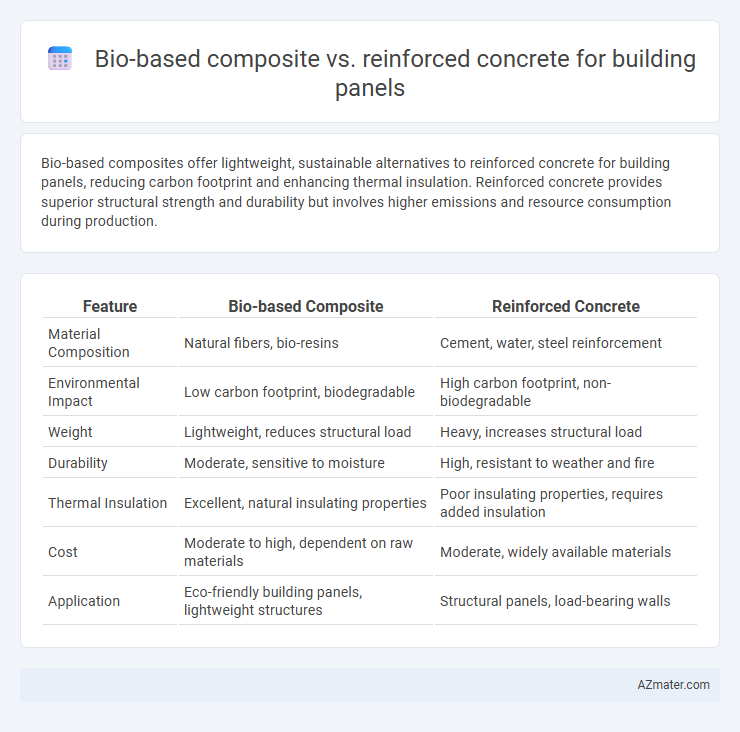Bio-based composites offer lightweight, sustainable alternatives to reinforced concrete for building panels, reducing carbon footprint and enhancing thermal insulation. Reinforced concrete provides superior structural strength and durability but involves higher emissions and resource consumption during production.
Table of Comparison
| Feature | Bio-based Composite | Reinforced Concrete |
|---|---|---|
| Material Composition | Natural fibers, bio-resins | Cement, water, steel reinforcement |
| Environmental Impact | Low carbon footprint, biodegradable | High carbon footprint, non-biodegradable |
| Weight | Lightweight, reduces structural load | Heavy, increases structural load |
| Durability | Moderate, sensitive to moisture | High, resistant to weather and fire |
| Thermal Insulation | Excellent, natural insulating properties | Poor insulating properties, requires added insulation |
| Cost | Moderate to high, dependent on raw materials | Moderate, widely available materials |
| Application | Eco-friendly building panels, lightweight structures | Structural panels, load-bearing walls |
Introduction to Building Panel Materials
Bio-based composites and reinforced concrete represent two innovative approaches in building panel materials, each offering distinct environmental and structural benefits. Bio-based composites utilize natural fibers such as hemp, flax, or bamboo bonded with bio-resins, resulting in lightweight panels with high thermal insulation and reduced carbon footprint. Reinforced concrete panels provide superior strength, durability, and fire resistance through embedded steel reinforcement, making them ideal for load-bearing applications in modern construction.
Overview of Bio-based Composites
Bio-based composites for building panels consist of natural fibers such as hemp, flax, or jute embedded in a bio-resin matrix, offering sustainability through renewable materials and reduced carbon footprint compared to reinforced concrete. These composites provide lightweight properties, thermal insulation, and resistance to corrosion, enhancing energy efficiency and longevity in construction applications. Their biodegradability and lower embodied energy make bio-based composites a compelling alternative to traditional reinforced concrete panels in eco-friendly building design.
Characteristics of Reinforced Concrete
Reinforced concrete combines concrete's compressive strength with steel reinforcement's tensile capacity, offering exceptional durability and load-bearing performance in building panels. Its high fire resistance, resistance to environmental degradation, and ability to be molded into various shapes make it a preferred choice for structural applications. The material's density and thermal mass contribute to energy efficiency but result in higher weight compared to bio-based composites.
Sustainability and Environmental Impact
Bio-based composites for building panels offer significant sustainability advantages due to their renewable raw materials, lower embodied energy, and enhanced recyclability compared to reinforced concrete. Reinforced concrete panels have a high carbon footprint primarily driven by cement production, which contributes substantial CO2 emissions and resource depletion. Utilizing bio-based composites reduces environmental impact by minimizing greenhouse gas emissions and promoting circular economy principles in construction.
Mechanical Properties and Structural Performance
Bio-based composites exhibit high tensile strength and flexibility, making them suitable for lightweight building panels with good impact resistance and energy absorption. Reinforced concrete offers superior compressive strength and durability, ensuring excellent load-bearing capacity and structural stability in heavy-duty construction applications. The choice between bio-based composites and reinforced concrete depends on the specific mechanical requirements, with bio-based composites favoring sustainability and flexibility, while reinforced concrete excels in long-term strength and fire resistance.
Thermal and Acoustic Insulation Capabilities
Bio-based composites offer superior thermal insulation with low thermal conductivity, reducing energy consumption in buildings compared to reinforced concrete panels, which typically have higher thermal mass but lower insulation properties. Acoustic insulation in bio-based composites is enhanced by their porous structure, effectively dampening sound and minimizing noise transmission, whereas reinforced concrete provides limited sound absorption but excels in blocking airborne noise due to its density. Selecting bio-based composites for building panels improves energy efficiency and occupant comfort by combining advanced thermal insulation with effective acoustic damping performance.
Durability and Lifespan Comparison
Bio-based composite panels demonstrate significant resistance to moisture, corrosion, and biological decay, resulting in enhanced durability compared to traditional reinforced concrete panels that can suffer from steel reinforcement corrosion over time. The lifespan of bio-based composites can exceed 50 years with proper maintenance, whereas reinforced concrete panels typically have a design life of 40 to 60 years but may require costly repairs due to crack propagation and reinforcement corrosion. Advanced bio-based materials offer superior dimensional stability and resistance to environmental degradation, making them a sustainable and long-lasting alternative for building panel applications.
Cost Analysis and Economic Viability
Bio-based composites for building panels typically offer lower material costs due to renewable raw materials and reduced energy-intensive processing compared to reinforced concrete. The economic viability of bio-based composites improves further with government incentives promoting sustainability and reduced lifecycle maintenance expenses. Reinforced concrete panels have higher initial costs driven by steel reinforcement and curing times but benefit from established supply chains and long-term durability in structural applications.
Applications and Design Flexibility
Bio-based composites offer superior design flexibility for building panels due to their lightweight nature and ability to be molded into complex shapes, making them ideal for customized architectural applications such as facades and interior partitions. Reinforced concrete provides high structural strength and durability, commonly used in load-bearing walls and floor panels where robustness and fire resistance are critical. The adaptability of bio-based composites allows integration with sustainable building practices, while reinforced concrete remains preferred for heavy-duty, large-scale construction requiring long-term performance.
Future Trends in Building Panel Technology
Bio-based composites for building panels offer enhanced sustainability and lower carbon footprints compared to reinforced concrete, aligning with global green construction trends. Advancements in biopolymer matrices and natural fiber reinforcement improve durability and fire resistance, positioning bio-composites as viable alternatives in mid-rise construction. Integration of smart sensor technologies within bio-based panels is anticipated to optimize structural health monitoring and energy efficiency in future building designs.

Infographic: Bio-based composite vs Reinforced concrete for Building panel
 azmater.com
azmater.com